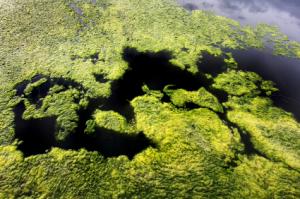

I attended the second session in a technical series discussing Advances in Algal Biorefineries and was struck by the theme I have seen developing this week: there are a lot of complex issues and solutions hinging on the simplest of problems. If you have been reading some of the same articles that I have, you've noticed that there is a lot of promising press about alternative energy, biofuels, and similar topics. Algae and plant oils have shown great promise towards answering the energy density question. The energy density is there, the algae can be grown, and the end product is viable. Yet there's one big catch at the moment. I am reminded of a 3-step business plan that I encountered in school (slightly modified for this venue): Step 1 - Collect algae, Step 3 - Profit. The presenters in this session were concerned with that mysterious Step 2.
The missing step that's holding back profitability

This seemed to me like a simple process: remove algae from solution and refine the lipids. It turns out that the starting solution is extremely dilute (in the order of 0.1% solids) and requires dealing with an extraordinary amount of water. If the solids can be increased to 2-5%, the process becomes much more reasonable. One presenter calculated that as much as 3,000 gallons of water could be needed to make 1 gallon of biodiesel. Many of the known techniques are energy intensive, thereby removing the value from the end product. From this simple problem statement (liquid-solid separation) come many different ideas.
Proposed solutions
One idea was to use a known concept, such as flocculation, similar to wastewater treatment. Some ideas were to alter the physical dynamic, through altering the physical makeup or using fungus that will incorporate the algae into pellets, making the solids easier to collect. I thought the most innovative idea was a change of the paradigm, trying to add a solvent that will extract the lipids from growing algae and allow for separation downstream. This would become a continuous process instead of a batch process, and all the nutrients and algae could remain in the system while the desired product is removed efficiently.
The simple details are what keep a promising technology from becoming a practical technology.



